Personality is a complex and multifaceted phenomenon, therefore modern psychology cannot yet develop an accurate and generally accepted definition of this concept. A huge variety of theories and concepts describing the nature and mechanisms of personality development have been united by researchers into basic theories of personality. In psychology, several theories of personality are actively being developed, among which five are recognized as the most significant: phenomenological, dispositional, behavioral, cognitive and psychodynamic.
Phenomenological theory of personality
In line with the phenomenological direction, the idea is emphasized that personal behavior can be characterized only in the terminology of its subjective perception and comprehension of reality. That is, this approach is based on the assertion that objectively existing reality is a reality that is consciously perceived and interpreted by a person at a certain point in time. Another equally important thesis of the phenomenological approach is the denial of fatalism, that is, the assertion that a person can build his own destiny, he has a choice in making decisions regarding his own life and the lives of others. However, a person must accept responsibility for the actions taken. The third position of the phenomenological approach is the recognition by its supporters of the positive nature of man and his desire for self-development and self-improvement.
Are you an expert in this subject area? We invite you to become the author of the Directory Working Conditions
A consistent interpretation of the phenomenological approach is presented in the works of the American psychologist C. Rogers, according to whom a person is a positive and reasonable creature who sincerely wants to live in harmony with himself and others. The driving force behind personal development, according to Rogers, is the desire for actualization, that is, the desire to preserve and develop oneself, showing the best qualities inherent in nature.
Act rationally or simply act
Modern science trusts only numbers - without a number (preferably a rational one), harmony cannot be measured. But in order for a theory to be born, it is necessary to agree on the axioms that will become its foundation. The foundation of classical game theory is the axiom of rational behavior of all players. This means that in every game there can be a value called utility, and all participants in the game not only understand this utility in the same way, but also strive to maximize it.
Mathematicians and economists, when studying game theory and decision making, refuse to consider the assumption that people behave less than rationally. And they are easy to understand: there are arbitrarily many private ways to explain a specific reason for making a decision in a game, but only one way - the theory of rationality - has a simplicity and generality that is inaccessible to private models. Life is, of course, a set of special cases, but theory must
study the case as general as possible. (Even if in each particular case the theory will not be absolutely correct.)
The main task of the institute, where the author worked before the well-known “geopolitical catastrophe,” was to protect the airspace of his then homeland. But the theoretical department in it was a kind of Athens Academy, whose employees were engaged in a lot of interesting things - from bionics to economics. Once the department was entrusted with helping fraternal Georgia in solving the problem of efficient transportation of railway cargo across its territory - the chairman of the Committee for Supply and Sales of the Georgian SSR, Mikhail Galaktionovich K., was close friends with the leadership of the institute. When the months-long work on the project was completed and the creators of the optimal solution presented a plan that would minimize the total costs of transportation, there was a complete breakdown. “What kind of optimality is this, dear,” Mikhail Galaktionovich was indignant. “Your part of the cargo bypasses Tbilisi!” What kind of boss am I, you know, if I can’t control everything myself?”
Oh, how right he was! Fifty years before this incident, one of the most famous economists, John Maynard Keynes, coined the term animal spirit to explain the nature and behavior of people:
people are driven not by the desire to maximize abstract “utility”, but by a spontaneous urge to act rather than inaction. If the developers had guessed to ask the customer what exactly he considers “useful”, the task could have turned out to be much simpler and would have resulted in a banquet at Aragvi.
Dispositional theory of personality
Dispositional personality theory is often characterized as a trait theory, which is associated with the main statement of this direction: a person has certain predispositions (dispositions) to specific reactions in various situations. These dispositions were called personality traits by direction theorists. In other words, a person demonstrates consistency in thoughts and actions, which is not influenced by either circumstances or the person’s previous experiences. In accordance with this, each personality is unique; its description is possible by characterizing its traits. Representatives of dispositional theory are Gordon Allport, Hans Eysenck and Raymond Cattell.
Finished works on a similar topic
Coursework Theories of personality. Theory of C. G. Jung 450 ₽ Abstract Theories of personality. Theory of C. G. Jung 270 ₽ Test Theories of Personality. Theory of C. G. Jung 210 ₽
Receive completed work or specialist advice on your educational project Find out the cost
Behavioral theories of personality
Sometimes this direction is called learning theory. The main thesis of behavioral theories boils down to the following: a person is the experience that she has acquired in life, what she has learned. The main source of personality development is the environment (in a broad sense), and the main elements of personality include reflexes and socialization skills. Behavioral theories of personality can be considered from the point of view of two directions. The first includes the works of famous American psychologists J. Watson and B. Skinner, who outlined one of the key ideas of classical behaviorism: human behavior is influenced by external circumstances and can be described by the formula: S → R. From the point of view of supporters of the second direction (A. Bandura and J. Rotter), the regulation of human behavior is carried out not so much by external environmental factors as by internal characteristics and ideas of the individual (goal, expectation, self-perception, etc.).
Cognitive theories of personality
This approach was actively developed in the works of the American psychologist J. Kelly, who believed that a person is like a researcher trying to understand what is happening to him, and based on this, predict what will happen in the future. That is why cognitive and intellectual processes have such a significant impact on a person’s behavior. J. Kelly argued that the world is perceived and interpreted by a person with the help of specific models, which the scientist proposed to call constructs. With this consideration, personality is a complexly organized system of the most important constructs, which reflect the feelings of the individual and its interpretation of previous experience. Therefore, relationships such as friendship and love are possible only between people who have similar constructs.
Too smart, or again at the red light
Once, one of the pillars of our department, Arkady Semenovich Nemirovsky, in the process of searching for a solution to some problem with uncertainty (a game with nature), showed that the optimal “player” who received a fine for some action (say, crossing the road at a red traffic light) should not do this action subsequently repeat.
It would seem, what could be more rational? And we decided - without really doubting the results, because among the subjects there were mainly candidates and doctors of science - to make sure that our homo sapiens
will not let you down.
Each subject was asked to press one of four buttons. After pressing the button, nature (represented by the author of these lines and Arkady Nemirovsky) reported the result - the number of units of rubles that the subject received or lost. It was announced that Nature is not malicious and does not indulge in random mechanisms. Therefore, as soon as the subject understands the algorithm, it will surely succeed
will win 10 rubles. From the conditions of the experiment, the choice of the optimal solution followed clearly: try all four actions, and then repeat the one where you are not penalized (and there was only one such thing).
Imagine the bewilderment of the researchers when not a single
of the subjects did not win 10 rubles. Somehow, no one could resist the temptation to return to an activity for which they had already been fined. For reasons of political correctness, the researchers decided that the subjects were too smart for such primitive rationality.
Meanwhile - which became known much later - the answer to the question of who should be considered more rational, adult kings of nature, their young children or other representatives of the animal kingdom, has long been of keen interest. Experiments reminiscent of Nemirovsky's game, but only with children from 4 to 15 years old, showed that the older the subjects, the worse their results. Older children, as it was written in one of the Western works, “ too smart for their own good”
. It turned out that the older the subjects, the greater their behavioral experience and the more often they get into trouble when using complex hypotheses in simple situations. Animals, once having found a safe way to a watering hole, do not leave it unless absolutely necessary. Evolution made it clear to them that they should not expect favors from nature.
Civilizations are, first of all, a search for new solutions, but such activities are difficult to recognize as rational. “Without being anywhere, the goal can be everywhere!” Nevertheless, people who “swim to swim” go against rationality over and over again. So far humanity is getting away with it.
Psychodynamic theories of personality
The starting points of the psychodynamic theory of personality were presented by S. Freud within the framework of the theory of “classical psychoanalysis” he developed. From the point of view of S. Freud, the key driving factor in personality development are innate instincts, which can be grouped into two main groups: life instincts (Eros) and death instincts (Thanatos). The researcher considered sexual instincts, the energy of which he called “libido,” to be no less significant for the development of personality. Later, the term "libido" was used by Freud to describe the energy of all life instincts. S. Freud also proposed three main personality structures, including:
- Id (It) – the source of motivating energy necessary to ensure the vital activity of the individual; Initially, this energy is realized in sexual and aggressive drives, which form the fundamental part of the Id; the key principle of the functioning of the Id is the pleasure principle;
- Ego (I) – a substructure of the personality that is responsible for making decisions;
- Superego (Super-I) is a system of values and norms of behavior that are accepted in society, on the one hand, and a system of punishments for violating these rules, on the other.
In accordance with this system, the personality functions as follows: Ego, taking into account the principle of reality, tries to satisfy the needs of Id, coordinating them with the requirements of Superego. Ego, Id and Superego are in constant struggle, conflicts between them can lead to mental and somatic illnesses.
However, the psychodynamic direction is not limited only to the concept of S. Freud. An important stage in the development of personality theory was the emergence of new supporters of the psychoanalytic movement, who criticized Freud and proposed their own concepts. These researchers include A. Adler and C. G. Jung.
According to A. Adler, integrity, creativity and the self-determining essence of the individual are of particular importance, and the driving force of its development is the desire for superiority (which, for example, can be dictated by compensation for feelings of inferiority caused by childhood events). Each person has a special, unique lifestyle, based on which he strives to achieve his goals. To understand a person requires a desire to understand his lifestyle. In Adler’s concept, a person appears not only as something whole in itself, but also as part of a much larger whole: family, circle of friends, acquaintances, society, humanity, belonging to which is consistent with his social interests.
The concept of C. G. Jung played a special role in psychology.
Personality structure. Basic approaches to understanding personality structure.
Man is the main element of the social structure, without which there can be no social interactions, no social communities, no social institutions.
Problems of man and personality are among the most important in the system of modern sociological knowledge. Of course, sociology does not have a monopoly on the study and interpretation of these problems (various sciences, religion, art, fiction).
Without specifically touching on the problems of man in art and religion, let us turn to the sphere of scientific knowledge. Addressing the problem of man, sociology interacts, first of all, with other social and human sciences, which contributes to their mutual enrichment. And it is possible to reveal the richness of understanding of issues related to “person” only on the basis of a number of categories, such as “person”, “individual” or “individuality”, “personality”.
A person displays the common traits characteristic of the human race. It (the concept) includes both biological and social characteristics.
An individual is a separate person, a unit of the human race, fulfilling the characteristic characteristics of a whole race. The concept of “individuality” means that special, unique, original thing that distinguishes this person from others (including both inherited and developed characteristics).
Personality is a stable system of socially significant traits that characterize an individual as a member of a particular society, as a product of social development.
This concept focuses attention on a certain integrity of his internal social psyche. qualities that characterize the features of his subjective relationship to the world. It is this side that is reflected in the term of the Germanic and Romance languages “persona”, i.e. the role that the individual must play in the "social drama".
In sociology, the concept of personality is used in two meanings:
· Firstly, personality is a normative type of person that meets the requirements of society, its value-normative standards (stereotype of behavior: collectivism, efficiency, cheerful disposition, etc.).
· Secondly, a person is a member of a social group, society, team, i.e. through its activities, included in various types of social systems.
Sociological concepts of personality are a number of theories that recognize the human personality as a specific formation, directly derived from certain social factors. The versatility of the process of formation, development and formation of personality has given rise to various concepts that differently emphasize certain aspects of this problem.
The works of C. H. Cooley (1864-1929) and J. Mead (1863-1931) reflected the theory of the mirror “I”, in which personality was interpreted as an objective quality acquired by a person in the process of social life.
Y. L. Moreno (1892-1974), T. Parsons (1902-1979), R. Lipton and others paid attention to the role theory of personality, according to which the latter is a function of the totality of social roles that a person performs in society.
The contribution of supporters of the status theory to the sociology of personality is significant.
In Russian sociology, scientists did a lot on the problems of human development, personality, both in the late 19th and early 20th centuries, and in the Soviet period.
In the pre-revolutionary period, personality problems were analyzed in sufficient detail in the works of P.A. Lavrov (1823-1900), E.V. de Roberti (1843-1915), P.A Sorokina (1889-1968). Interesting observations about the morals, habits, and orientations of the peasant were made by A.N. Engelhardt (1832-1893). But the role of N.K. Mikhailovsky (1842-1904) is especially significant, who proposed considering personality in three forms: biogenic, psychogenic and sociogenic guises . He paid a lot of attention to the problem of individuality.
During the Soviet period, B.G. did a lot to develop the theory of personality and its sociological and socio-psychological interpretation. Ananyev, V.G. Alekseeva-Kharcheva, L.P. Bueva, I.S. Kon, L.A. Zelenov, A.G. Zdravomyslov, V.N. Lavrinenko, A.V. Petorvsky, B.D. Parygin , K.K. Platonov, G.L. Smirnov, E.V. Shorokhova, E.B. Shestopal, I.T. Frolov, V.A. Yadov and others.
The words of the famous American sociologist C.R. Mills (1916-1962) are fully applicable to the analysis of sociological problems of personality, who wrote that “the study of sociology should show how to evaluate oneself not as an isolated individual, but as a person in a sea of humanity; help place yourself in history and perspective to better understand and evaluate the factors that influence both your behavior and the behavior of other people.” Social structure of personality.
Personality can be viewed as the integrity of biological, psychological and social components.
1. Biological component - what is transmitted at the biological level, physiological parameters of a person (health / unhealthy)
2. Psychological component - a set of emotions, experiences, volitional aspirations, memory, abilities, etc.
3. Social component - a set of subjective and objective properties of an individual that arise and function in the process of their various activities. Hence, the most important characteristic of the social structure of a person is his activity as independence and as interaction with other people.
All of these structural elements are found in every personality, although to varying degrees. Each person, one way or another, participates in the life of society, has knowledge, and is guided by something. Therefore, the social structure of the individual is constantly changing. The individual receives new information, new knowledge. This knowledge, under certain conditions, turns into beliefs, and they, in turn, determine the nature of a person’s actions.
The structure of any complex phenomena, and the human personality certainly belongs to them, is a collection, hierarchy and a certain interaction of various elements. Any structure has a certain stability and at the same time is subject to various changes - progress and regression - up to collapse, which is characterized by the concept of destruction. Destructive phenomena in the personality structure lead to various kinds of deviations, called deviant behavior.
The sociological structure of the individual includes a set of objective and subjective properties of the individual that arise and function in the process of his various activities, under the influence of those communities and associations to which the person belongs. Hence, the most important characteristic of the social structure of a person is his activity as independence and as interaction with other people, which is fixed by the concept of the subject of activity. An analysis of the structure of a personality without an analysis of the forms of its activity is impossible.
Value orientations act as social attitudes of an individual and regulate his behavior. They reflect the fundamental interests of the individual and determine the strategic direction of its activities. They manifest themselves as the individual’s life position, his worldview, and moral principles. Holistic orientations are formed when an individual assimilates social experience, masters social, political, moral, aesthetic ideals and immutable normative requirements imposed on him as a member of a social community
14. Socialization of personality. Factors in personality formation .
It is known that a baby enters the world as a biological organism and its main concern at that moment is its own physical comfort. After some time, the child becomes a human being with a complex of attitudes and values, with likes and dislikes, with goals and intentions, patterns of behavior, as well as with a unique individual vision of the world. A person achieves this state through a process we call socialization. During this process, the individual becomes a human person.
Socialization is the process of an individual’s assimilation of patterns of behavior, social norms and values necessary for his successful functioning in a given society. Socialization is a specific feature of human society. In animals, only its simplest form is learning. There are widely known cases where human cubs were raised by animals. When such children were found, it turned out that the “jungle children” did not know how to think, speak and participate in social interaction. Returning to society, they were able to learn only the most basic skills, mastering oral speech, consisting of 30 words. But this would not have happened if it were not for the genetic inheritance, the biological predisposition of the human race to learn. The “isolants” never learned to be friends, smile, think abstractly, or have a conversation.
This is a complex process of formation of a personality, its life position based on the influence (impact) on a person of the system of training, education and upbringing, including family, media, literature, art. The process of socialization covers all spheres of human (personal) life – from infant games to work and rest in adulthood and old age.
Socialization represents the contradictory unity of two defining trends:
· Unification, which manifests itself in the individual’s desire to be like everyone else, in mastering generally accepted abilities of communication and activity, stereotypes of mass consciousness, and
· Individualization, which is expressed in the desire to form one’s “I”, to develop original ways of communication and activity.
The process of socialization goes through stages that, as a rule, correspond to the main life cycles : childhood, adolescence, maturity, old age. Within the approximate framework of these cycles, a person gains political, economic and social independence. Within the same framework, the process of personality formation simultaneously takes place. At the initial stage of socialization (childhood, adolescence) we are dealing with an individual who gradually becomes aware of his social “I”; at the third and fourth stages, with the successful completion of the socialization process, with a personality.









